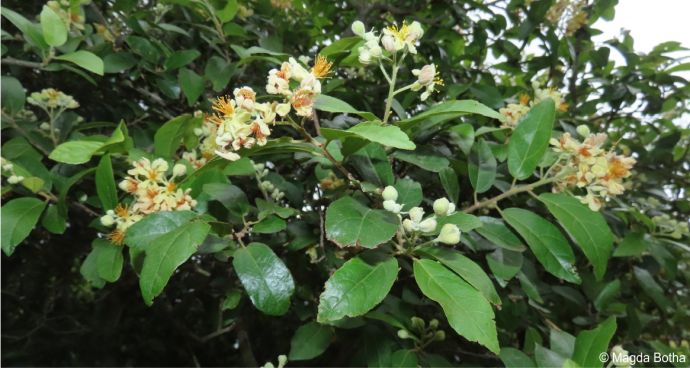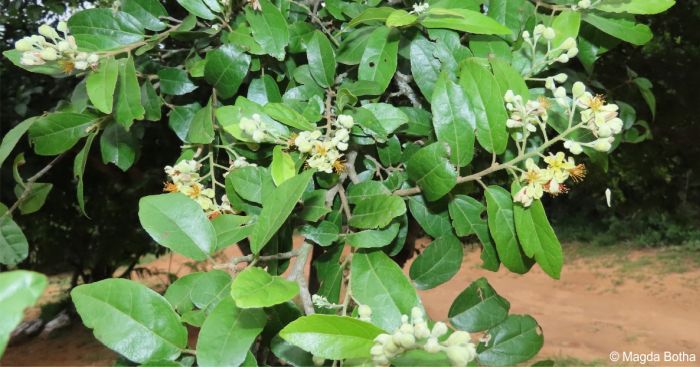Grewia microthyrsa
Grewia microthyrsa K.Schum. ex Burret
Family: Malvaceae
Common names: sand raisin (Eng.), sandrosyntjie (Afr.), mufuka (Tshivenda), nsihana (Xitsonga), umunywane, ilalanyathi, ikolo (isiZulu).
SA Tree No: 461.1
Introduction
An indigenous shrub with edible fruit and attractive flowers.

Description
Description
A shrub or small tree, usually reaching a height of 2 m but capable of reaching 4 m in a forest. It is multistemmed, the stems with smooth, pale grey bark, the branchlets with long white hairs at first, but eventually becoming hairless and grey in colour. Leaves simple, alternate, oblong to elliptic, 20-60 mm long and 13-25 mm wide, glossy green on the upper surface and pale on the lower surface, apex rounded to widely tapered, the upper and lower surfaces are glabrous, and the leaves are borne on stalks which are tomentose. Flower buds are covered with velvety grey to brown hairs, opening into cream to pale yellow flowers, 12 mm long, in small terminal clusters, in early to mid summer (from October to January). Ovary generally, 3-locular, loculi 3–4 ovulate, smooth, not lobed. Style smooth and 5 mm long. Fruit oval, 7 x 13 mm, never lobed, reddish-brown when ripe, pendulous, smooth, available in late summer to autumn (from February to May).

Conservation Status
Status
Grewia microthyrsa is not threatened, according to the Red List of South African Plants this species is assessed as Least Concern (LC).
Distribution and habitat
Distribution description
The distribution of Grewia microthyrsa ranges from KwaZulu-Natal to Limpopo Province in South Africa, and this species is also found in the southern part of Mozambique. It grows in sand forest, open woodland, dry bushland or dry mixed woodland at low altitudes.

Derivation of name and historical aspects
History
Carl Linnaeus gave the genus Grewia its name in honour of the English physician and botanist Nehemiah Grew (1641–1712). Grew was a pioneering plant anatomist and microscope researcher in his era, and his research on pollen created the foundation for palynology as we know it today. The name microthyrsa means ‘small inflorescence’ and derives from Greek origins, micro- is a Greek prefix that translates to ‘small’ or ‘tiny’, and the term thyrsa originates from the Greek word thyrse, which literally means ‘wand’ but in botany refers to a type of inflorescence.

Ecology
Ecology
There are numerous kinds of Lepidoptera caterpillars whose diets revolve around Grewia species. These incorporate the Endoclita malabaricus commonly known as swift moth and the Polyura athamas (common nawab). Larvae of butterflies in the Hesperiidae family have been identified to rely on Grewia species as a food source. Various animals, such as duiker and bushbuck, feed on Grewia microthyrsa.

Uses
Use
Grewia microthyrsa is one of the species whose branches are used as wall laths when constructing houses by rural communities such as the Manqakulane community in Maputaland, northern KwaZulu-Natal. The stems have also been used as spear shafts. The fruit is edible and enjoyed by humans and birds when ripe. To increase male fertility, the root is simmered in water, discarded, and the water is then drunk.
Growing Grewia microthyrsa
Grow
Grewia microthyrsa can be propagated from seeds or stem cuttings. Collect mature seeds and plant them in a well-drained seed mix. Maintain a consistently moist soil until germination occurs. For stem cuttings, select healthy, non-flowering stems, dip the cut ends in a rooting hormone, and plant them in a suitable rooting medium. Maintain a warm and humid environment until rooting takes place. Sand raisin prefers well-draining, fertile soils. Depending on the climate and season, modify the frequency of watering. Pruning Grewia microthyrsa on occasion will help keep it in shape and encourage bushier growth.
References
- Boon, Richard. 2010. Pooley's trees of eastern South Africa, a complete guide. Flora & Fauna Publications Trust, Durban.
- Botha, M.J. (aka magdastlucia). 2021. Observation of Grewia microthyrsa, KwaNibela, KZN. iNaturalist. Online. https://www.inaturalist.org/observations/101717504.
- Botha, M.J. (aka magdastlucia). 2022. Observation of Grewia microthyrsa, iSimangaliso, KZN. iNaturalist. Online. https://www.inaturalist.org/observations/122845630.
- Burrows, J., Burrows, S., Lotter, M. & Schmidt, E. 2018. Trees and shrubs of Mozambique. Print Matters Heritage
- Corrigan, B.M., Van Wyk, B.E., Geldenhuys, C.J. & Jardine, J.M. 2011. Ethnobotanical plant uses in the KwaNibela peninsula, St Lucia, South Africa. South African Journal of Botany 77(2):346-359.
- Gaugris, J.Y. & Van Rooyen, M.W. 2009. Evaluating patterns of wood use for building construction in Maputaland, South Africa. South African Journal of Wildlife Research 39(1):85-96.
- Jooste, R. & Viljoen, C. 2021. Grewia caffra Meisn. (Malvaceae). PlantZAfrica. Online. https://pza.sanbi.org/grewia-caffra.
- Makgakga, C. 2019. Grewia retinervis Burret (Malvaceae). PlantZAfrica. Online. https://pza.sanbi.org/grewia-retinervis.
- Mokganya, M.G., et al. 2017. An evaluation of additional uses of some wild edible fruit plants of the Vhembe District Municipality in the Limpopo Province, South Africa. Indian Journal of Traditional Knowledge 17(2):276-281.
- Palmer, E. & Pitman, N. 1972. Trees of southern Africa. Balkema, Cape Town.
- Raimondo, D., Von Staden, L., Foden, W., Victor, J.E., Helme, N.A., Turner, R.C., Kamundi, D.A. & Manyama, P.A. (eds) 2009. Red list of South African plants. Strelitzia 25. South African National Biodiversity Institute, Pretoria.
- Wild, H. 1963. Grewia microthyrsa. Flora Zambesiaca 2(1):33.
- Wild, H. 1984. Tiliaceae. Flora of Southern Africa 21(1):1-43. Available at https://www.biodiversitylibrary.org/item/209546#page/13/mode/1up.
Credits
Nompumelelo Nkosi and Mpho Mathalauga
Pretoria National Botanical Garden
October 2023
Acknowledgments: the authors thank Magda Botha for the images.
Plant Attributes:
Plant Type: Shrub, Tree
SA Distribution: KwaZulu-Natal, Limpopo
Soil type: Sandy, Loam
Flowering season: Early Summer, Late Summer
PH: Acid, Neutral
Flower colour: Cream, Yellow
Aspect: Full Sun, Morning Sun (Semi Shade), Afternoon Sun (Semi Shade)
Gardening skill: Average
Special Features:
Horticultural zones








Rate this article
Article well written and informative
Rate this plant
Is this an interesting plant?
Login to add your Comment
Back to topNot registered yet? Click here to register.